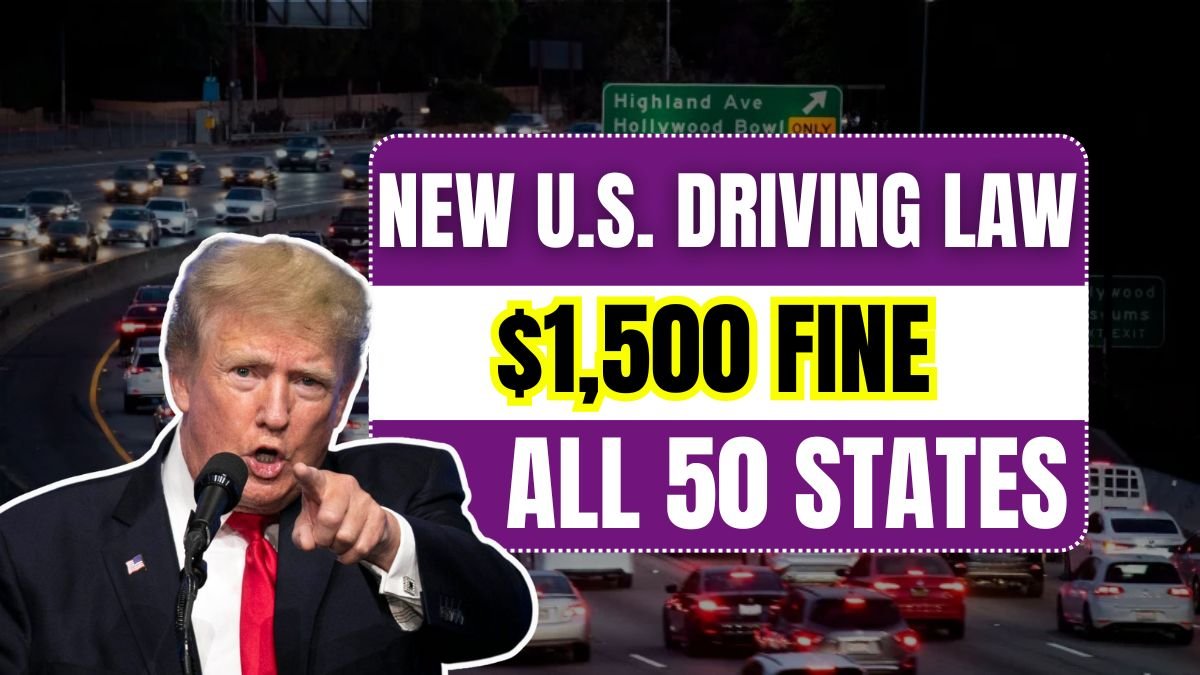A major change is set to take effect across the United States starting October 2025. For the first time, uniform and strict traffic rules will be implemented in all 50 states, under which using a mobile phone or any electronic device while driving could result in a hefty fine of up to $1,500 and even a jail sentence. This law was passed under the National Roadway Safety Enforcement Act (NRSEA), which aims to curb the increasing number of road accidents. This law is not just a change in rules, but is considered a step that will usher in a new era of road safety in America.
Why the New Law Was Implemented
The number of road accidents has steadily increased over the past few years, and the main reason for this has been attributed to distracted driving, i.e., using a mobile phone while driving. In 2024 alone, more than 3,100 people died in the United States because drivers were busy looking at their phones, texting, or browsing social media. The data also revealed that approximately 8% of traffic fatalities were linked to mobile phone use, and nearly 25% of rear-end collisions were caused by driver distraction. This problem is even more severe among young people, as 42% of teen and young drivers admitted checking text messages while driving.
These alarming statistics prompted the US Congress to enact national regulations that would be uniformly enforced in every state to strengthen road safety nationwide.
What the New Law Says
This law, which takes effect in October 2025, completely prohibits the use of any handheld mobile phone or electronic device while driving. Drivers will no longer be able to engage in activities such as:
- Texting
- Scrolling social media
- Recording videos
- Making phone calls
- Using handheld GPS
While various states previously had different rules, the new law ensures uniform and stringent penalties nationwide.
Drivers can still use Bluetooth or voice-assist technology, as long as they don’t hold the device. This means they can continue using in-car navigation, voice-controlled calling, and infotainment systems.
New Penalties and Punishments
Under this new rule, penalties have become stricter than ever before.
- A first offense is punishable by a $500 fine.
- A second offense increases to $1,000 and up to three days in jail.
- A third or subsequent offense results in a $1,500 fine and 10 days in jail.
Additionally, the driver’s license can be suspended for up to six months.
Penalties are harsher if an accident occurs. If someone is injured or killed due to mobile phone use:
- The driver may face up to one year in jail
- Additional fines determined by the court
- Possible permanent license revocation
Why Uniform Rules Were Necessary in All States
Road safety laws in the US previously varied widely. In some states, mobile phone use was treated lightly; in others, it brought moderate fines. However, the rise in accidents showed that inconsistent rules were ineffective.
Therefore, USDOT and NHTSA ordered all states to adopt uniform rules.
Any state failing to implement the rule by October 2025 may face a cut in federal highway funding, speeding up nationwide compliance.
Stricter Monitoring Will Begin in October 2025
Once the law takes effect, all state and local police will enforce it strictly. Officers now have special powers allowing them to:
- Issue fines immediately
- Arrest any driver seen using a phone, even if the vehicle is at a traffic signal
Police will monitor drivers through:
- Roadside cameras
- In-car smart systems
Special surveillance will increase in school zones, traffic signals, busy intersections, and highways—areas most vulnerable to distracted driving.
Additional Rules for Commercial and School Bus Drivers
The law applies to all drivers, but commercial vehicle drivers and school bus drivers face stricter rules.
- Commercial drivers cannot use any electronic device, even hands-free.
Penalty: $1,500 fine + CDL suspension for 60–120 days - School bus drivers face even harsher rules due to child safety concerns.
Penalty: Up to 15 days in jail + $1,500 fine - Fleet operators may also face penalties up to $10,000 for employee violations.
Additional Regulations by States
Although federally mandated, states can add extra rules. Examples include:
- California: Mandatory defensive driving courses for offenders
- Texas: License suspension for second offenses
- New York: Notice sent to insurance companies, raising premiums
- Florida: Double fines in school or construction zones
- Illinois: Double points for repeat offenses within 12 months
These additions reflect each state’s unique needs and driving patterns.
Special Exemptions in the Law
The purpose of the law is safety, not inconvenience. Therefore, exemptions include:
- Calling 911 during emergencies
- Use by police, firefighters, or EMS personnel while on duty
- Use by drivers who are safely parked with the engine off
However, glancing at a mobile screen while driving is considered a violation unless the phone is fixed to the dashboard and controlled through voice or steering controls.
Public Awareness Campaign
USDOT has launched a campaign titled “Eyes on the Road, Hands on the Wheel”. Awareness efforts include:
- TV and radio advertisements
- Social media campaigns
- Real-life stories from accident victims
- School seminars
- Senior driver workshops
Insurance companies are offering lower premiums to drivers who install phone-disabling technology, encouraging safer habits.
New Technology and Future Planning
Models entering the market in 2025 are equipped with new technologies such as:
- Driver Focus Monitors
- Alerts when drivers pick up their phone
- Data logging for distracted behavior
This aligns with the Vision Zero Initiative, which aims to reduce traffic deaths to zero by 2050.
Major automakers like Toyota, Ford, Tesla, and General Motors are contributing to this effort, integrating advanced safety tech.
Legal Rights and Appeals
Drivers who feel wrongly fined can appeal in court. However:
- The burden of proof lies on the driver
- They must demonstrate that the phone was used in permitted conditions
- Missing court dates may cause immediate license suspension
Rehabilitation programs exist for offenders, but repeated violators may be barred from them.
Economic and Social Impact
This new law will significantly affect the U.S. economy and society.
- Road accidents cost billions annually
- Reduced accidents will lower:
- Hospital expenses
- Legal costs
- Insurance claims
Insurance companies will reward safe drivers with lower premiums.
Socially, the law will build a sense of responsibility, especially among youth. It will improve overall safety and push America toward a more disciplined driving culture.
Conclusion
This new law taking effect in October 2025 is not just another rule, but a step toward transforming road safety. Provisions such as $1,500 fines, jail time, and license suspension send a powerful message: America will no longer tolerate mobile phone use while driving.
No message or notification is more important than a human life.
By keeping your phone away while driving, you avoid punishment and protect lives on the road—including your own. This law will play a critical role in making America a safer, more responsible driving nation for years to come.
FAQs
1. When will the new U.S. driving law take effect?
The law will be enforced nationwide starting October 2025 with uniform penalties.
2. What is the maximum fine for using a mobile phone while driving?
Drivers can be fined up to 1,500 dollars for repeated offenses under the new rules.
3. Are there any exemptions under this law?
Yes, emergency calls like 911 and on-duty emergency staff such as police and firefighters are exempt.


